« July 2006 | Main | September 2006 »
August 31, 2006
The Dive Shop Blues
I must have exceptionally bad luck with dive shops. First the one where I took my PADI Open Water certification classes closed down three days after I bought thousands of dollars worth of scuba equipment. I got it all, no problem there, but I sure didn't like to have spent extra to support my local dive shop just to see them close on me. And I am also not pleased that almost a month after my certification dives, I still don't have my PADI C-card.
So a couple of weeks ago I found a new shop, closeby. I bought more equipment and was looking forward to a great relationship, more classes, dives, and so on. That may still happen, but so far it's been a bit rough. I have not had a response to my emails. Those are important to a dive shop, and so I must assume they got lost in a spam filter.
Last Saturday I stopped by to have my tanks filled. Unfortunately, the shop was closed. They probably went to do open water dives in a nearby lake. Not so cool for customers who need tanks filled. It wasn't a real big deal for me, but I wish I'd have known ahead of time.
So this morning I loaded a big steel 95 tank into my PT Cruiser, secured it, and drove to the dive shop again. Business hours 10 to 6 or so. Sadly, at 10:30 no one was there and the shop was closed. So today I am driving around with a steel tank in my car. Again, what if I had really needed a fill?
I've probably just been unlucky and there were good explanations why the shop was closed and what happened to my emails. I'll try again tomorrow.
Posted by conradb212 at 10:56 PM
August 28, 2006
Struggling after certification
Well, it's been over three weeks since my PADI certification. My enthusiasm for all things Scuba continues. I've been buying every scuba book I can get my hands on, I spend hours on the web researching scuba, and I continue to learn more and more from my partner in this website, Carol, who is a certified NAUI instructor.
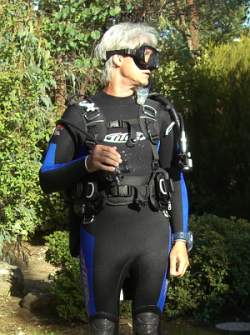 Unfortunately, my practical experience is lacking. Or maybe it isn't. They say you should get diving right away after you get your C-Card as statistics show an alarming percentage of newly certified divers never don scuba gear again after their certification. Well, the C-Card is a bit of a sore subject as I still haven't received mine, after three weeks. My certification dive buddy, Holly, received hers ten days ago, so I am getting concerned. The PADI site, supposedly, offers a way to inquire about cards never received, but I can't find it. So no C-Card yet. No real big deal as I have the PADI certificate signed by instructor Chuck with whom, after numerous emails and proposed calls and meetings, still have to connect. And of my "graduating class," no one seems interested to get together or at least communicate. With the exception of Holly with whom I've stayed in touch.
Unfortunately, my practical experience is lacking. Or maybe it isn't. They say you should get diving right away after you get your C-Card as statistics show an alarming percentage of newly certified divers never don scuba gear again after their certification. Well, the C-Card is a bit of a sore subject as I still haven't received mine, after three weeks. My certification dive buddy, Holly, received hers ten days ago, so I am getting concerned. The PADI site, supposedly, offers a way to inquire about cards never received, but I can't find it. So no C-Card yet. No real big deal as I have the PADI certificate signed by instructor Chuck with whom, after numerous emails and proposed calls and meetings, still have to connect. And of my "graduating class," no one seems interested to get together or at least communicate. With the exception of Holly with whom I've stayed in touch.
At least I have all my gear, and so I HAVE actually managed to log some good bottom time. Yes, its still only in "Dim Cove," the name I have given my pool. Last Saturday I logged my second wetsuit dive there, 67 minutes. I spent the time practicing various of the skills we had learned: flooding and clearing the mask; taking the mask off entirely with eyes open, then put it back on and clear it; undoing the weight pockets from my Knighthawk BC; switching between the primary air supply and the AIR2 secondary air supply that is part of the BC; fin pivots and trying to achieve totally neutral buoyancy; slowing my breathing to minimize air usage. I felt thrilled that towards the end, for a few glorious minutes I did achieve perfect buoyancy and slowly just floated.
I also learned that you get a very dry mouth after a while, and that you MUST wash out the mask very thoroughly if you use a commercial de-fogger. I didn't, and so one of my eyes started getting irritated. And.... with a bit of allergy rearing its ugly head, your nose can get quite plugged up after a while. There are ways to deal with that.
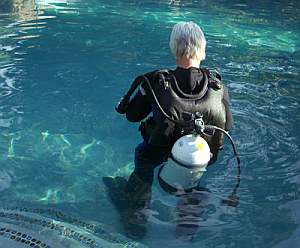 I spent a lot of time with my dive computer, a ScubaPro/Uwatec Smart-Z. It is a wrist-mounted unit that looks like a very large watch. It's air-integrated and wirelessly communicates with the small black transmitter screwed into a high pressure port on my first stage. I watched as "remaining air-time" went from 60 minutes all the way to 99 minutes, the max the computer displays, as I laid still and slowed my breathing.
I spent a lot of time with my dive computer, a ScubaPro/Uwatec Smart-Z. It is a wrist-mounted unit that looks like a very large watch. It's air-integrated and wirelessly communicates with the small black transmitter screwed into a high pressure port on my first stage. I watched as "remaining air-time" went from 60 minutes all the way to 99 minutes, the max the computer displays, as I laid still and slowed my breathing.
Once out of the water and all dried up, I uploaded the dive computer's data into my notebook. It uses an infrared interface, a bit archaic perhaps as IR is on its way out, but so far it still works. Once uploaded, you can peruse every part of your five. It is really quite spectacular, and very much reminds me of analyzing a datalog recorded by the Hondata K-Pro computer in my supercharged Acura RSX. Both monitor vitals and let you play them back. Both show you all the parameters, so you can learn, adjust, record, and make corrections.
So for now I am a theoretical diver much more so than a practical one. True, I logged "bottom time," but I am not sure it counts just in a backyard pool. It DOES give me experience in donning equipment, doing all the safety checks, and then practice underwater. But not that much more.
I really wish the Hudson Dive Center had not gone out of business. I wish the new dive shop I found would be a bit more proactive in going after obviously enthusiastic new divers (last Saturday when I went there to fill my tank, it was simply closed ebcause they'd gone to do certification dives; hey guys, didn't I tell you I wanted to come along?). And I wish I had been part of a more enthusiastic dive class that wants to stay in touch and get together to explore.
Posted by conradb212 at 10:55 PM
August 21, 2006
Finding a new shop, equipment, and practicing
Well, my dive shop Alma Mater, the Hudson Family Dive Center in Rancho Cordova, CA, is gone for good. I stopped by and the shop is already cleaned out. Something bad happened here, and maybe I'll never know what. I really liked John Hudson, but if he knew trouble was brewing, selling me $2,500 of gear two days before he closed shop just wasn't right.
In the meantime I was supposed to discuss things with our dive instructor, but beyond an exchange of a few emails that hasn't happened yet, and so the Hudson story remains a mystery. I've been keeping our little graduating class informed via email, and at least one of them reciprocates. Apart from mourning the loss of my dive center and local shop, my biggest concern was getting our C-Cards. Chuck was going to let us know about that. Yesterday I got a note from Holly, my certification dive buddy, that hers had arrived. Yeah. I hope mine will shortly.
And I found a new local dive shop. I had called ScubaPro for their recommendation on service on my all-ScubaPro gear, and they had recommended Dolphin on Marconi, a ways away from me. Holly told me that whatever classes and commitments Hudson had left unfilled would be handled by ScubaWorld at http://www.scubaworldsacto.com/. Unfortunately, that's even farther from where I live. So I perused the web again and, low and behold, found a NAUI shop right here in Folsom. I stopped by and talked to owner Robert Flores. Five minutes into the conversation he let me read a two-page article of his where he, quite distinctly, explained why he switched allegiance from PADI to NAUI. Some rivalry there for sure.
So I looked around the shop, tried on some masks, asked a bunch of questions about classes (they do Nitrox), and inquired about tanks. Robert said a buddy of his had two used steel 95 cuft tanks that I might want. While I was somewhat tempted by one of those beautifully red or blue-anodyzed aluminum tanks, I knew that steel was better altogether, and expressed my interest. I did buy a mask with some sideview and a purge valve, just to learn how they feel and start building my own collection of scuba gear...
On Saturday I took my 10-year-old son up to Folsom Lake where we had done the certification dives. I hardly recognized the place! The water level had fallen a good five feet and the "parking lot" was now above water. The shore line, as a result, had changed dramatically. It was weird to see the parking lot that I had perused while diving now used by SUVs and trucks that launched their boats. My son and I walked along the scraggly shoreline of Folsom Lake for an hour or two. That was fun.
Then back to Divers Cove in Folsom where I closed the deal on the tanks. Once again I felt like a total noob. I had neither asked how old the tanks were, nor what make, nor what pressure rating. Carol had to point all of that out to me, and advised what I should offer. Well, I ended up buying both tanks for $360. They are Fabers, "low pressure," (i.e. nominally 2,400 psi, but usable up to 2,800 or so) and probably three years old, painted white. The 95s are quite hefty; not longer than the 80s I'd used during the C-dives, but thicker. I also got weights: four blue 4-lbs bags and two red 5-pounders. Carol later suggested I should have gotten smaller denominations instead, like a 2-lbs and a 3-lbs instead of one 5-lbs.
Yesterday I assembled all my gear and took it for a "maiden voyage" into ... my pool. Yes I know, it's just a pool, but it's still diving, looking up at the world above water, and breathing air from a tank. I familiarized myself with my ScubaPro Knighthawk BC, puzzled over how to attach the regulator properly and which hose went where, and wondered what my air-integrated, wireless Uwatec Smart-Z dive computer would do underwater. Well, the steel tank was a handful, and I am not sure yet I like the smallish plastic molding on the back of the Nighthawk as it seems to let the tank slip and slide too much no matter how tightly I set the clasping mechanism.
In the water, the steel tank seemed less buoyant than the aluminim tanks I'd been using, and I needed to inflate the BC to keep things afloat until I had it all on me. Then I went under and stayed there for 22 minutes. I found that the computer simply comes on and then displays a standard set of information: Oxygen percentage, current and maximum depth, dive time, remaining bottom time, remaining air pressure, and occasionally a couple of others. At one point a small icon appeared that I later identified as a pair of lungs, indicating "increased workload warning." I was pleased that I could see the large numbers well, and even the small ones, without optical adjustment. Of course, there was a lot of light.
I loved the freedom the Knighthawk BC provided. None of the bulk upfront, and unlike with a vest, you don't feel it when the air bladder inflates. I still need to find a good way to memorize whether it's the round or square button that inflates and deflates, but that'll become second nature soon enough. I really like the ScubaPro second stage and mouthpiece; very comfortable. And the Air2 BC-integrated secondary air supply also works well. So far so good. The "weightless" aspect of being underwater still presents problems. I often feel I am not in control of how and where my body moves, and I need to learn to control all that without flaying around.
Later I learned, much to my chagrin, that I had the first stage on wrong! I had the secondary chamber with the low pressure ports point up, where it could hit my head. It really should only go on one way, the right way! Considering that air is of vital importance, the fact that there aren't markings neither on the tank nor on the regulator as to what points where and what is up and down is sort of alarming! And as someone who works on tuned cars, the total absence of torque specs for all of those connections, nuts and bolts perhaps even more so. "Tighten lightly" seems awfully imprecise for something that provides life under water!
Posted by conradb212 at 10:54 PM
August 16, 2006
Watcha do when your dive shop goes under?
Well, a most revolting thing happened. I got a call on my answering machine from my instructor saying that Hudson Dive and Aquatic Center in Rancho Cordova, Calif., closed down. Say what? I just bought $2,500 worth of gear there a few days ago!
Well, I call up the dive shop and, sure enough, there is a heart-wrenching message from John, the owner. He is so sorry to inform us all that due to unforseen circumstances he had to close the shop. Everything will be refunded. He is so very sorry. Anything further, please call this number.
I call and the number is a legal firm. The dive shop had filed for bankruptcy.
I have very mixed feelings. I didn't see that coming. Usually, the stench of death permeates a shop that is about to go under. The shelves are bare, there is an aura of desperation, people you'd known have left. There was none of that at the Hudson Family Dive Center. The shelves were well stocked. There were always plenty of people there. But then again, one doesn't just wake up one morning and think, "Hmmm, maybe I should declare bankruptcy before I go go get me a bagel..."
So I wonder what happened. I had bought all my diving gear there because I wanted to support my local dive shop, my scuba alma mater. I could have bought my stuff online for less, but I wanted to build a relationship by buying local. By supporting my dive center, who'd then know and support me when I needed advice or a favor. That's the way it works.
I had planned on buying or renting a tank so I could practice some skills in my pool. Now I don't even know where I'll get my C-Card from. Or who will handle my equipment service and handle my warranty. Probably some other shop, but they won't embrace me with open arms as "my" dive center would have. And they are farther away. So John should have told me... "You know what, I can't do it any longer. I'd love to sell all this to you, but I cannot in good conscience."
I've been playing phone and email tag with Instructor Chuck. He seems to want to organize something for Sacramento area divers and look out for us. Hey, maybe he wants to buy the dive center, or maybe I should. Who knows. But this sure put some, ummm..., cold water onto things. Like hitting a really bad thermocline.
Posted by conradb212 at 10:54 PM
August 11, 2006
Buying your diving gear.... some advice
Scuba ain't a cheap sport. Sure, you can get away with just getting your basic mask/snorkel/fins package and rent the rest whenever you go diving, but that's not much fun. Everytime you rent you have to get used to a different BC and regulator, and another set of instruments. No fun. So if you did make the commitment to get into scuba diving, with all the costs of trips and such, you might as well bite the bullet and get your own gear. If you're ready for that, here are some tips from a total noob (well, not THAT total anymore).
RESEARCH BEFORE YOU BUY -- If you're the type who just walks into a store and buys whatever the sales person recommends or whatever is on sale, so be with. It might work. And dive shops generally have very good sales people who'll quickly figure out what might work for you. Still, do some research first! Heck, I did so much that it ended up being an entire website on scuba equipment. Yes, this entire site came into being because I researched and googled until I felt I knew enough to make some informed decisions (and then decided I might as well write it all down for others). Doing research doesn't mean you won't end up buying stuff that turns out to be wrong for you, but at least you didn't go in blind.
BEWARE OF STRONG OPINIONS -- Yes, there's a war going on in the dive industry. Many wars, actually. And if you don't know the sides and players, you may encounter some, shall we say, strong opinions. For those of you who are into cars, let me give you an analogy that may resonate: See, naively asking a dive expert or instructor or sales person about, say, the benefits of ScubaPro versus Oceanic equipment is like asking a diehard Chevy fan what he thinks about a Ford Mustang... Actually, it's even worse. So tread lightly until you get a handle on scuba brand politics. Very lightly.
WETSUITS! -- You need a wetsuit. No doubt about it. Now here's totally mandatory advice: when you go buy one, plan on spending several hours and do not plan on buying anything else that day. That's because trying on wetsuits is a hideous, exhausting, frustrating struggle and you will find that dive shops never have airconditioning in their changing booths. If they do, it's not strong enough. You HAVE to try on wetsuits because it's very important to have one that fits right. But take my word for it: if it goes on easy, it's too big. If you find yourself cursing and sweating like a pig by the time you get one on, it fits just right. By that time you will be so exhausted that you are in NO shape to make ANY other buying decisions. So leave, cool off, and come back for the rest of the gear some other time. And try not to think how many other nice folks tried on the one you settled for...
DIVE COMPUTERS -- Anyone who's taken the basic Open Water course knows dive tables and what a pain they are. You have to understand how they work, no doubt about it. But the prospect of having a dive computer that does all the calculating for you and always tells you what to do is very nice indeed. And with the text books and instructors all gushing on how dive computers have revolutionized the diving industry, chances are you'll want one right away. I sure did. Major Tom to Ground Control: Those things are a bitch to figure out! I consider myself a computer expert, and I've yet to figure out even the very basics of the advanced dive computer I bought. It looks like a very, very large digital watch and it occasionally beeps and shows lots of numbers and icons. The instructions were quite obviously written by someone who assumes the reader is already an expert diver and totally familiar with dive computers. Honestly, do not ever expect to get a dive computer and then do a dive after a five minute intro. There MAY be dive computers that let you do that. Mine isn't. And if you're computer-challenged, you may be better off with old-fashioned pressure and depth gauges and the dive tables. Honestly, at this point I'd PAY for a two hour introduction on how my dive computer works.
BUY LOCAL! -- These days, we buy more and more stuff on the internet. It's often easier and cheaper and much less of a hassle. Don't do that with scuba gear. For two reasons:
The first is that building a relationship with your dive shop means they support you and you support them. Dive shops rely on equipment sales to stay in business. So if you just pick their brains, try on all their gear, and then order from RockBottomScubaDiscount.com, don't be surprised if your shop goes out of business or if they dont like you so much.
The second is that you really and truly need to try out scuba gear before you buy it. You can research masks forever, and all the research won't tell you which one fits your face. Only trying it on will tell you that. Same for snorkels and fins. You need to try them on to see if they feel "right." And , especially if you're new to the sport, you definitely want to try on various BCs and have the sales people explain them to you. And a wetsuit? See above. You absolutely need to try that on (oh joy!).
So there. Advice from someone start starting out. It worked for me, so far. I know I'll make mistakes, and not even the best advice works for everyone.
Posted by conradb212 at 10:53 PM
August 6, 2006
We are PADI CERTIFIED!
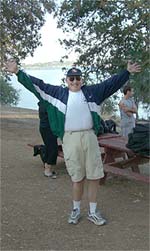 There are things that only happen once in your life. Graduations, various firsts, things that we'll remember forever. Getting our PADI certification this morning was one such moment. After the two final open water dives, instructor Chuck proclaimed: "You are now certified!" Yeah!!!
There are things that only happen once in your life. Graduations, various firsts, things that we'll remember forever. Getting our PADI certification this morning was one such moment. After the two final open water dives, instructor Chuck proclaimed: "You are now certified!" Yeah!!!
Sure it was "only" three or four weeks of classes, some diving in a pool, and then dives in a lake. But it was also more than that. We learned to handle ourselves underwater, with equipment that keeps us alive in an environment that mankind cannot live and breathe in, an environment that evolution made us leave a gadzillion years ago. And we did not only learn how to handle that equipment and stay alive, but we also learned how to help another diver and keeping him or her alive as well.
Am I proud to now be a Certified Open Water Scuba Diver? Hell yes. Very much.
So how did it go? Once again we had to be at the Folsom Lake Browns Ravine at 7AM sharp. Which made for a short night for me. Everyone arrived on the button, and this time instructor Chuck Odell, again in high spirits, did not waste any time. And neither did we. No more tentative shlepping of stuff from here to there. We knew exactly what we needed and where it had to be. No need to bring the second tank until you need it. Nor any other gear.
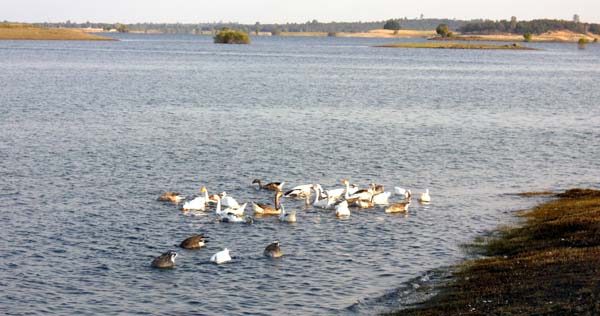
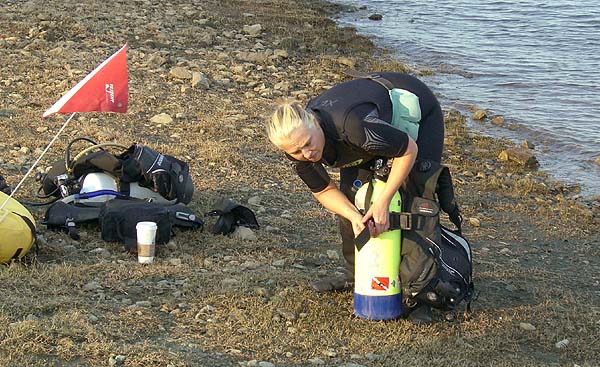
So descended down to the shore and suited up quickly, much to the chagrin of a good-sized flock of geese and ducks and such. Then into the water and snorkel swimming out to the buoy, using compass navigation. My buddy is Holly again, and this time we agree that she leads and I follow. 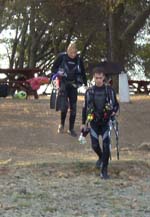 I grab the yellow buoy anchor line to descend, keep an eye on her, but in an instant she's gone. At the bottom, some 25 feet, I see Julie and Spencer. Chuck wants us to do full mask flooding and clearing (no problem), then fin pivot to practice neutral buoyancy, then free float a few feet off the bottom.
I grab the yellow buoy anchor line to descend, keep an eye on her, but in an instant she's gone. At the bottom, some 25 feet, I see Julie and Spencer. Chuck wants us to do full mask flooding and clearing (no problem), then fin pivot to practice neutral buoyancy, then free float a few feet off the bottom.
Since my buddy still hasn't reappeared, Chuck fills in to do the out-of-air exercise with me. He signals out-of-air, I acknowledge and hand him my secondary air-source. I make sure he has it in his mouth, then grab him firmly by the shoulder of his BC and give the "up" sign. He acknowledges and we swim up. He actually goes a bit faster than I expected, but that must have been the right speed. From the surface we see Holly at the shore. She had lost her weight belt and gone back to retrieve it. Chuck goes down again to work with Julie and Spencer. Holly rejoins me.
Then something a bit scary happens. Chuck comes up with a gasping diver, the woman who had not been part of our class but joined us with her partner for certification. We're concerned as she keeps gasping for air. Turns out she'd had problems with the alternate air supply attached to her BC and gulped a bunch of water. Fortunately she's okay. In stuations like this, it sure is comforting to know you have a former Navy SEAL as your instructor.
We go down again to "burn some air" and reach perhaps 27 feet. Then Open Water Dive 3 is over. We don't actually go out of the water this time, but spend a lot of time on the surface waiting for everyone to go through their exercises, and then listening to Chuck on what'd we'd do for the final dive.
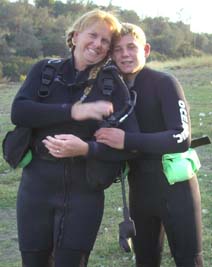 We really only had one skill left to practice in open water, and that was the dreaded Controlled Emergency Swimming Ascent (CESA). The assumption here is that you're out of air and your buddy is not closeby. So up you go after you gulp whatever air may be left in the tank. But do not hold your breath, ever!! So you swim up at a controlled rate, constanty blowing bubbles and making an "Ahhhhh" sounds so that you release the air that greatly expands in your lungs as you go up. Remember: going up from 25 feet to the surface almost doubles the volume of air.
We really only had one skill left to practice in open water, and that was the dreaded Controlled Emergency Swimming Ascent (CESA). The assumption here is that you're out of air and your buddy is not closeby. So up you go after you gulp whatever air may be left in the tank. But do not hold your breath, ever!! So you swim up at a controlled rate, constanty blowing bubbles and making an "Ahhhhh" sounds so that you release the air that greatly expands in your lungs as you go up. Remember: going up from 25 feet to the surface almost doubles the volume of air.
I get to go first. Chuck gives me the sign that I am out of air. I acknowledge. He uses his fingers to count to three, then gives me the "up" sign. I begin blowing bubbles as I fin up. Chuck holds on to me and is right beside me, just in case that I stop blowing bubbles. I don't, and soon we're at the surface where I try to stay afloat and blow up my BC with my mouth at the same time. I had dreaded that exercise as it'd been a bit scary in the pool. Amazingly, in the open water, going up from 25 feet to the surface, it was an entirely different experience. I never ran out of air. It was as if my lungs were getting new air all the time, though I didn't cheat once.
Chuck did the exercise with all students, then we got to do more underwater navigation. 50 kicks 240 degree, then turn to 60 degrees. My buddy and I agree that she will lead and I will follow, and we resolve not to get separated. We go under and the visibility immediately drops to perhaps six feet. We hit a mild thermocline and eventually descend to about 33 feet. We stay close and despite the poor viz manage to stay together until ... the visibility drops to perhaps three to four feet. I still see Holly's fins, but they grow fainter and, dang, she's gone! I accelerate, but no luck. So I search a bit more, then go up. She's not far and we both laugh.
Then it's back to the shore, take off the gear, wrap things up. Chuck makes us fill out our logs for open water dives 3 and 4. Hey, we end up in pressure group "J", at least if we use the tables. A dive computer probably would have seen things a bit differently.
Chuck uses his digital camera to take shots of each of us for the official records. and presumably our C-Cards. And he dutifully signs all the log books and initials this and that. Then we are done.
We are now PADI Certified Open Water Divers!!!!
Posted by conradb212 at 10:52 PM
August 5, 2006
TWO DOWN! (and two to go)
Listen up, bandicoots.... diving in open water ain't the same as in the pool!
If you've never done it, it'll be a big surprise. It's all different. For me it was my first two open water dives after weeks of classroom work and "confined water" pool diving and exercising. I have to admit, I was nervous. And I HATE to get up early. But we had to be there at 7AM sharp, and so I was. Browns Ravine, Folsom Lake, California. Amanda and Stacy were already there, and after a bit of searching we found the right spot.
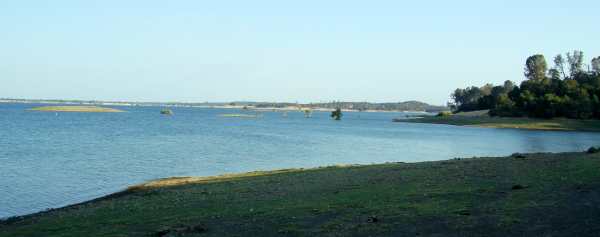
So then it was unloading all the gear, and that's where a whole bunch of little logistical thingies came into play that aren't ever discussed in class, nor are they in any video or textbook. Where do you park your gear? Like right next to the water? Or do you set up some sort of base camp? At Folsom Lake it's a fairly steep descent down to picnic tables and then down to the beach. So we shlepped our gear to the tables, then left some there and took the rest down by the lake. Umm... what do you do with your valuables? Will there always be someone tending the farm? Like a "security buddy" or "designated gear watcher"? Even if you leave all your stuff in the car, what about the car key? Put that in a pocket of your BC or clip in somewhere? Not with today's electronic keys you don't.
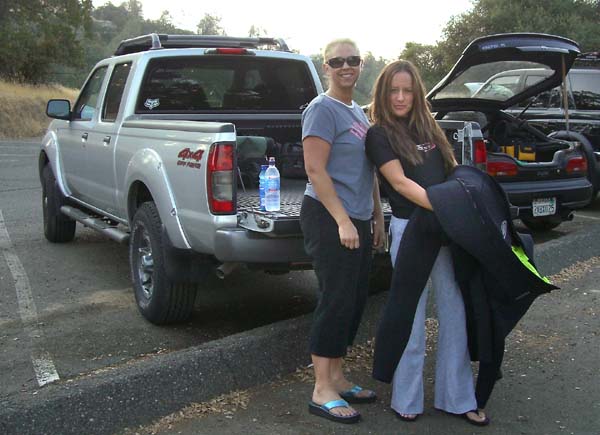
Fortunately, a few family members accompanied us eight aspiring divers and so security was taken care of. Julie and Spencer got lost and so we had some extra time to get all set up. The picture above shows Amanda and Stacy.
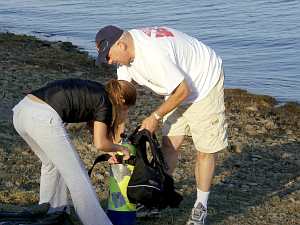 Okay... where to start? It was actually much colder than I thought at 8am on an August 5th in California. Water temperature almost 80 degrees, air much cooler. So I struggled into the bottom part of my "Farmer Johns"... just to find that I had them on the wrong way. Off they came. And back on. No fun, even though they were not very tight. Instructor Chuck is in a splendid mood, but excuses himself to go to the bathroom before he gets geared up (I'd soon find out why).
Okay... where to start? It was actually much colder than I thought at 8am on an August 5th in California. Water temperature almost 80 degrees, air much cooler. So I struggled into the bottom part of my "Farmer Johns"... just to find that I had them on the wrong way. Off they came. And back on. No fun, even though they were not very tight. Instructor Chuck is in a splendid mood, but excuses himself to go to the bathroom before he gets geared up (I'd soon find out why).
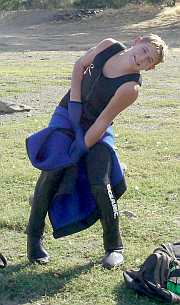 So down by the beach we go, including one big 80 cu-ft tank and the rest of the gear, dunk the BC in the water, and assemble the tank/BC/regulator. This time Holly is my buddy; she'd already taken the course and been in the lake several times, but had not done all her certification dives due to some problems up in Lake Tahoe. We're rather loose about how and where to put on fins and BC and all, and I struggle a bit as I can't see my feet/fins at all in the muddy water. And the BC weighs a ton with the much bigger 80 cu-ft tank, so I make it float and put it on in the water. It seems to leak a bit, but Chuck says it's just overinflated.
So down by the beach we go, including one big 80 cu-ft tank and the rest of the gear, dunk the BC in the water, and assemble the tank/BC/regulator. This time Holly is my buddy; she'd already taken the course and been in the lake several times, but had not done all her certification dives due to some problems up in Lake Tahoe. We're rather loose about how and where to put on fins and BC and all, and I struggle a bit as I can't see my feet/fins at all in the muddy water. And the BC weighs a ton with the much bigger 80 cu-ft tank, so I make it float and put it on in the water. It seems to leak a bit, but Chuck says it's just overinflated.
Continuing in the tradition of whatever I fear not happening and whatever I don't expect happening, I have no problem at all with the wetsuit. Water isn't sloshing around, it feels nice and tight without being restrictive. It may look like crap, but it sure works. The mouthpiece, on the other had, chaves against my gums. Oh, and shlepping all the heavy gear brought on some disconcerting pain signals from my lower back.
So then it's time to go down into the lake, a real lake, real open water... my very first real dive. What will it be like? What will I see? Will I be able to compensate? Will I freak?
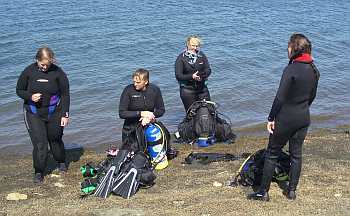 Instructor Chuck explains the scenery and the plan. He refers to the "parking lot" and then the rocks beyond it. Parking lot? Well, it IS a parking lot. During the fall and winter time the water level in the lake (created by the huge Folsom Dam) is much lower and it is indeed a parking lot. So down we go and I find myself floating over a parking lot. Really weird. Visibility is quite limited, perhaps ten feet, so we all stay close together.
Instructor Chuck explains the scenery and the plan. He refers to the "parking lot" and then the rocks beyond it. Parking lot? Well, it IS a parking lot. During the fall and winter time the water level in the lake (created by the huge Folsom Dam) is much lower and it is indeed a parking lot. So down we go and I find myself floating over a parking lot. Really weird. Visibility is quite limited, perhaps ten feet, so we all stay close together.
We pass the edge of the parking lot and now it goes down. At perhaps 20 feet we hit a thermocline. Now we all had read about thermoclines, but you have to experience one to really know what it means. It goes from warm to really cold just like that. It's spooky initially, as if you'd hit "the deep," some sort of cold and clammy dead zone.
Now we're at the bottom, perhaps 25 feet or so. Equalizing turns out not being much of a problem. It's really just doing more of what we had to do in the pool. I sort of had expected both ears to equalize the same time, or at least make the same sounds. They don't. And you never quite know when you have to equalize, or what technique might work.
 Chuck had warned us not to touch the silty bottom with our fins, but that is easier said than done. So before long visibility drops to perhaps five feet. We gather around Chuck and do some exercises. Partial mask flooding and clearing. Not too much. Just getting used to being down there in a real lake, in real open water. Then we dive around a bit, not seeing very much at all. I quickly lose my buddy Holly (I know, I know...). And I realize that, perhaps as part of the thermocline, I have to pee real bad. But up we go, slowly, passing back into warmer water, then breaking the surface. It'd felt like we had been down there for an hour. But it'd only been 15 minutes.
Chuck had warned us not to touch the silty bottom with our fins, but that is easier said than done. So before long visibility drops to perhaps five feet. We gather around Chuck and do some exercises. Partial mask flooding and clearing. Not too much. Just getting used to being down there in a real lake, in real open water. Then we dive around a bit, not seeing very much at all. I quickly lose my buddy Holly (I know, I know...). And I realize that, perhaps as part of the thermocline, I have to pee real bad. But up we go, slowly, passing back into warmer water, then breaking the surface. It'd felt like we had been down there for an hour. But it'd only been 15 minutes.
Oh, and another big surprise! One of my major worries had been that I would not be able to see the instruments because I need 2.0 reading glasses. Amazingly, underwater everything was crystal clear. That was much more of a difference than I expected. I knew underwater opitcs make everything seem 1/3 larger and closer, but the effect is greater than expected.
Now I have to go really bad and know why Chuck emptied his bladder before donning his suit. I trek over to the restrooms and struggle out of my suit enough too pee. Life is good. After 50 minutes or so we're ready for the second dive.
 This time getting all geared is a little easier, though I am certain Carol would chide me for the, shall we say, 'inconsistent' habits I have acquired. Once we're all set up and ready to roll, Chuck explains the second dive. We're doing surface navigation out to the anchored buoy, snorkeling. Once there, we'll descend to the bottom, just short of 30 feet, and will do full mask flooding and clearing, and then a simulated emergency out-of-air. Chuck will point at one of us who will acknowledge, sigal the buddy, do the out-of-air sign, wait for the buddy to make the alternate air supply available, and then descend to the surface.
This time getting all geared is a little easier, though I am certain Carol would chide me for the, shall we say, 'inconsistent' habits I have acquired. Once we're all set up and ready to roll, Chuck explains the second dive. We're doing surface navigation out to the anchored buoy, snorkeling. Once there, we'll descend to the bottom, just short of 30 feet, and will do full mask flooding and clearing, and then a simulated emergency out-of-air. Chuck will point at one of us who will acknowledge, sigal the buddy, do the out-of-air sign, wait for the buddy to make the alternate air supply available, and then descend to the surface.
So we set our compass bearings and off we go. I strictly follow the course, sure that I'll hit the buoy any minute, but then I hear Chuck calling me. I look at and the buoy is way off to the side. How did this happen? Well, even if you follow the course exactly, a current can carry you off, which is what happened to me. Once there we give each other signs, then descend...
Into what can best be described as pea-soup. Once again I almost immediately lose my buddy, Holly. I see Julie and Spencer who also seem lost, so they make the ascend sign and I follow, slowly. By the time I am up, I see no one. So I swim over to the buoy and descend down the line, joining Chuck and the other three.
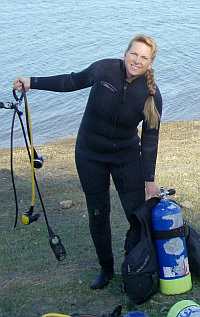 Actually, all I can see is a faint outline of Holly, who's all of two feet away, and Chuck's mask inches away from me. Viz is that bad. So I do the full mask flooding, no problem. Holly does the same. Then do (or approximate) fin pivots and then some neutral buoyancy floating. All in pea-soup. Chuck pulls Holly and I close and signals that I am out of air. I signal Holly who releases her BC-mounted alternate for herself and gives me her primary. I signal okay, and we slowly ascend to the surface.
Actually, all I can see is a faint outline of Holly, who's all of two feet away, and Chuck's mask inches away from me. Viz is that bad. So I do the full mask flooding, no problem. Holly does the same. Then do (or approximate) fin pivots and then some neutral buoyancy floating. All in pea-soup. Chuck pulls Holly and I close and signals that I am out of air. I signal Holly who releases her BC-mounted alternate for herself and gives me her primary. I signal okay, and we slowly ascend to the surface.
Chuck finishes with the others, then asks us to do some "tired diver" tows. Fun, that, and so Holly and I ferry around until all are done with the pea-soup exercises.
Now Chuck wants us to reset the compass for another landmark, swim in that direction for four minutes, then do a 90 degree left, all at depth. Down Holly and I go, trying to follow the compass. I think I am doing it just right, but then the needle veers way off and Holly, whom I had seen just seconds ago, has disappeared again. So I ascend, to find her bobbing on the surface a ways away. I decided to go down again, diving over to her. With marginal success. Holly and I seem unable to hang on to each other. So next time I'll make her lead and I follow!
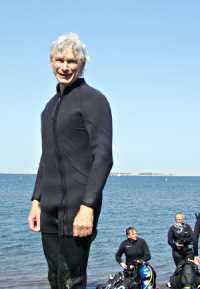 I use the rest of my time diving towards the shore, closely watching my instruments, noticing how I ascend and descend, and how my ears react to the pressure difference. I try to establish totally neutral buoyancy, be horizontal in the water, fin just right, and all that is fun. Then I approach the shore, and the rest of the crew as well.
I use the rest of my time diving towards the shore, closely watching my instruments, noticing how I ascend and descend, and how my ears react to the pressure difference. I try to establish totally neutral buoyancy, be horizontal in the water, fin just right, and all that is fun. Then I approach the shore, and the rest of the crew as well.
We struggle out of the water, employing various methods taking off our gear and hefting it up the slope. We compare notes; everybody did reasonably well, though a few things misfired. Julie had vicious heartburn the whole time. Spencer's snorkel came off and got lost. One of the others could not pressure compensate her ears and had to ascend. Stacey, who had seemed quite intimidated and afraid, beams as she did well. Amanda is getting used to her gear, after some initial problems with getting properly weighted.
Chuck now wants our log books and so we sit down and make our first two entries. Dive 1 and Dive 2. Yeah! Lots of data. I help out some of the others. Then we hand them in, try to get dry, try not to get our gear too dirty, try to get it all back up to the cars without collapsing. :-)
Then it's driving home. I am both elated and exhausted. As I write this it is hours later. I went to the Hudson Dive Center to get my tank refilled. I am still elated and more exhausted yet. Still, I managed to hose off my gear, write all this, and relate my experiences.
Now I am going to lay down. I have a slight headache. I am told, hey, it's the nitrogen. From such shallow and short dives, I ask? Yep. Go have a nap. Will do. -- Conrad
Posted by conradb212 at 10:57 PM
Getting ready for first ever open water dives
Well, it's 6AM and in an hour I am supposed to meet the rest at Browns Ravine on Folsom Lake for what will be my first ever Open Water dives. I am still waking up, having my coffee, and wonder what kind of experience it will be. My PT Cruiser is loaded up with all the gear: wetsuit, BC, two 80cu-ft tanks, fins, mask, snorkel and all my gear. The Folsom Lake Marina Cam may or may not show the exact place where we'll be.
Truth be told, I am rather apprehensive. In my head I go over and over again about what it may be like. Certainly much different than going to the 15-foot "deep" end of the indoor pool. At Folsom Lake we'll be going down to 40 feet or more. Will my ears equalize properly? What will the water be like, look like? Will the visibility be totally different? Will there be gunky stuff? Fish? How will we change? Where will be leave our stuff? Will someone watch over it? Where do I put my car keys? And this morning my back hurts a bit?
Am I jeopardizing my health by getting into a sport that requires heavy lifting and negotiating all that weight on my back? After all, only a few years ago I had almost resigned myself to a life of constant, permanent backpain that then miraculously disappeared. Will lifting the tanks and all make it come back?
All this is going through my head as I am getting ready. Hey, even other stuff? What if I get lost and don't find Browns Ravine? Will I forget some crucial part of my gear? I wish I had a buddy to meet beforehand and go there with. Right now, I feel alone. I know this is the start of something new, something that probably will get me places I've never been to, the start of a new life in many ways. Right now it just feels like this big thing ahead of me. I also know that a mere six hours from now, I'll have done my first two open water dives and will probably be thrilled with excitement. I sure hope so.
Well, wish me luck. And those of you who are experienced divers, I hope you remember your own mixed feelings before your first forway into open water... Oh, and today would be my dad's 87th birthday if he were still alive. I am pretty sure he wouldn't have any fears at all, and just jump right into it all.
Posted by conradb212 at 10:50 PM
August 4, 2006
Gearing up for the open water dives!
Well, last night was the last session before the two open water certificaton dives in Folsom Lake. With all classroom work done, we talked a lot about diving gear, assembled all the stuff we needed for the open water dives, and got to spend a bunch of time in the pool!
Amanda had ordered all of her gear and took possession of her brand-new BC, regulator and computer. All Oceanic stuff. She's quite the action gal. Instructor Chuck and I continued our debate over the relative merits of Oceanic versus ScubaPro. Chuck, of course, knows vastly more than I do about the pros and cons of equipment and companies, but since I already have ScubaPro mask, fins and snorkel, and the co-founder of ScubaDiverInfo.com is a diehard ScubaPro supporter, I am leaning that way. Eventually, the owner of the store gave me quotes on both an Oceanic and a ScubaPro package.
On we went to get our gear for the open water dives. This was also to be our first experience with wetsuits. Chuck explained the trials and tribulations of donning a wetsuit, then pulled one out for each of is. Not the common one-piece kind, but two-piece "Farmer John" and "Farmer Jane" models. I got mine on fairly easily, but that was probably because it wasn't very tight. I am tall and slender, and so my rather beat-up Farmer John is probably too loose on me. Not that I know how tight it's supposed to be. I'd had visions of looking pretty cool in a wetsuit, but the well-worn, loose-fitting garb was reminiscent more of a deflated Michelin Tire man than an imposing/menacing Batman. Spencer struggled to get into his (much tighter), and the ladies, of course, looked terrific in theirs.
We also got to pick tanks, two of them. I got 80s, the women and 14-year-old Spencer 65s. Man, those things are heavy! I am no longer surprised that serious divers pack some muscle. Then weight belts. Chuck packed them with 28 pounds. 10% of body weight plus 12 pounds in sweet water.
Then it was playtime, or rather practice time. A fifth student had joined us, Stacy. She'd been nursing an injury and so this was only her second night in the pool, which meant that instructor Chuck had to catch her up on all the stuff we'd learned the prior few pool sessions. The rest of us were free to practice whatever we wanted, and that turned out to be lots of fun.
The next two hours or so we spent diving. Laps around the pool. Mask clearing. Alternate air source breathing. Taking the BC off at the bottom and putting it back on. Fin pivots. Neutral buoyancy practice. Controlled emergency ascent simulation. And so on. This was by far the most fun I'd had diving to-date. Amanda quickly got used to her new gear and did well, as usual. I think I made good progress, though the second time I took my BC off underwater, I accidentally undid the shoulder clasp instead of just loosening it. So then I got the low pressure airhose caught in it and "Mom" Julie came to the rescue. She'd make a fine dive master.
Then we were done. Instructor Chuck emerged with a visibly hard-worked Stacey and proceeded to explain the logistics of the Saturday and Sunday dives at Folsom Lake. Be there at 7am sharp. Both days. Auggh. We logged all our rental equipment, then shlepped it all to our cars. I made three trips. How come golfers have caddies for just a lousy golf bag, and divers have none? I mean, we have a lot more gear!
Anyway, I left the session all worked up and thrilled. I am a bit apprehensive about the actual open water dives, a bit scared. We'll be going a lot deeper than the 15 feet in the pool. And who knows what's down there in that lake. But I am looking forward to it as well! Very much so.
Posted by conradb212 at 10:49 PM
August 3, 2006
PADI Open Water Final Test - Never too old to be nervous
On Tuesday night we had the final classroom test for the PADI Open Water Course. That was in addition to the five self-study Knowledge Reviews and the four 20-question class-room tests.
PADI's teaching approach may be geared towards a general audience, but you can't say it's superficial. Unless you hit the books pretty hard (yes, reading and comprehending it all takes many hours), you're going to miss quite a few questions. Even though many are of the multiple-choice variety where it's pretty obvious which choice does not fit. The role of the instructor in all this is that of discussing and emphasizing the really important stuff. And that's what ours did. He spent a lot of time on what matters, and even more on some of the technical stuff, like understanding dive table calculations. He didn't cut any corners there, none.
I am by far the oldest in our class and I've certainly done my share of tests and exams in my life, and I was definitely well prepared for the final 50-question test. So why was I nervous anyway? Nervous as in "what if I totally lose it and blow a bunch of questions?" I knew no one would actually fail unless they really didn't study at all and showed no interest to learn or participate. Even then, the instuctor would probably try to work with them and tutor until they got it. Yet, as instructor Chuck once more recapped all the salient points of each chapter in the book, and then went through two more dive table examples, I got ever more nervous, feeling pretty foolish over it. After all, I do hold a doctoral degree from an engineering university.
So then Chuck hands out the test and off we go. I slowly and methodically answer the first five questions, then hit a rythm and it all falls into place. The dreaded dive table questions aren't so tough (a few hours prior I had still struggled with some of the logistical concepts) and I do them all in my head, not using the dive table templates the instructor had handed out. So when Chuck comes back in to inform me that the URL of our scubadiverinfo.com site, this site, didn't seem to work, I follow him into the office as I am done. They have a glacially slow dial-up connection and the site does indeed not come up. Drat. I had proudly written the URL on the whiteboard so my fellow students could check it out.
Some time later Chuck reviews our tests. I ace it. All answers correct. That makes me feel extraordinarily proud, almost giddy. I have a big smirk on my face for the rest of the evening. I've definitely passed far more difficult tests and exams, but for some reason acing this one makes me proud and happy.
We're all too pooped from the test to go into the pool and discuss scuba gear instead, looking at this and that, trying on BCs, checking out regulators. My on-and-off diving buddy, Amanda, volunteers that she'd given up smoking last year and gained a bit of weight, which seems to bug her a great deal. Unnecessarily so, in my opinion, as she looks great, and I tell her that. Then again, I am biased. She decides to get a BC small enough so she can't get any bigger. Women. :-)
Chuck explains the pros and cons of various BCs, regulators and computers with me. He remains as high on Oceanic as my NAUI instructor advisor and partner is on ScubaPro, so I'll have to do some more research. Then Chuck goes through all we'll be doing in preparation for our open water checkout dives at Folsom Lake. We'll be selecting and packing gear on Thursday, today. Then hit the confined water pool for some extended diving one last time.
Posted by conradb212 at 10:47 PM








